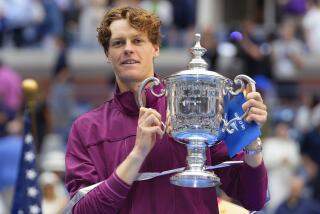It’s All About a Bow After Agassi’s Defeat
- Share via
MELBOURNE, Australia — Instead of exiting stage left, walking directly to the tunnel leading off the court at Rod Laver Arena, Andre Agassi detoured, turned right and headed toward the area between the net and the service line.
He dropped his equipment bag, bowed and accepted the adulation of a cheering crowd.
How many times have we seen this after an extraordinary victory by Agassi?
But this time, the extraordinary victory had been posted by his opponent, Marat Safin of Russia.
Safin ended Agassi’s 26-match winning streak at Melbourne Park, defeating the fourth-seeded defending champion, 7-6 (6), 7-6 (6), 5-7, 1-6, 6-3, in the semifinals Thursday night at the Australian Open.
With the retractable roof closed because of inclement weather, Safin had 33 aces and, almost incredibly, no double faults.
This might have been Agassi’s farewell moment Down Under. Or, a just-in-case, no-regrets insurance moment. For every Martina Navratilova, taking a keepsake blade of grass from Centre Court after her last singles match at Wimbledon in 1994, there is a Pete Sampras, lamenting that he ended his Wimbledon career on Court 2, falling to a lucky loser.
“Just saying thank you to them,” Agassi said. “They’ve been great to me over the years. Just a lot of fun to compete in front of. And you never know when it’s your last, right? So you want to say ‘bye properly.”
The chances of his returning here in 2005, however, remain “pretty good,” Agassi said.
“I have no plans to do otherwise. But, you know, a year’s a long time. I really look forward to coming back.”
Clearly, it was an emotional night for Agassi. His eyes glistened as he spoke in the interview room after the marathon match, which lasted 3 hours 42 minutes. This was only the fourth time that the four-time champion had lost in 48 matches at the Australian Open, and the first since Vince Spadea beat him in 1999 in the fourth round.
Initially, Safin was at a loss for words.
“I still don’t know,” he said in his on-court interview. “I don’t have the words to describe it.”
Agassi had two set points in the first, served for the second set at 5-4 and had a set point in the tiebreaker, only to emerge trailing, two sets to love. Still, he kept chipping away in his usual strategic way. With both players hitting hard, though, the semifinal looked like a chess match played on fast forward.
Once Safin fell behind in the fourth set, he conserved his energy for the fifth, then broke Agassi’s serve in the fourth game when Agassi pulled a forehand wide, which proved decisive.
Said Safin, who will play either No. 2 Roger Federer of Switzerland or No. 3 Juan Carlos Ferrero of Spain in the final, “I think I played one of my best matches in my whole life, probably. I managed to stay with him on the baseline. I managed to serve 33 aces. For me, it’s a big thing, especially against him.”
Agassi kept his sense of humor when it was pointed out that Safin had not double faulted.
“Please ask him that and then call me and tell me why he did that,” Agassi said, smiling. “I hate it when he does that. Yeah, it’s a good effort.”
It was never easy to get a read on the old, unpredictable Safin; now comes the new, inspired Safin. Playing 27 sets in six matches, knocking off Americans in four consecutive matches and reaching a Grand Slam final after missing a good portion of last year with an injured wrist, the 24-year-old Russian, who is ranked 86th, has been a revelation here.
The foundation, though, was laid in December. When Agassi was running up his familiar hill in Las Vegas, Safin was putting in hill work and interval training six days a week in Monte Carlo, according to his trainer Walt Landers.
“One month makes a difference,” said the demonstrative Landers, who added that they had used some of the training techniques of runner Sebastian Coe, Olympic gold medalist in the 1,500 meters in 1980 and 1984.
Even at his worst, Safin had the ability to flick on his talent like a light switch, such as when he blew out Sampras in the 2000 U.S. Open final. Though he is also remembered for losing the 2002 Australian Open final, it was Safin who beat Sampras in what turned out to be Sampras’ last match in Melbourne, a four-set, fourth-round loss to the Russian.
Will Safin also be the one remembered for taking out Agassi in his last match at the Australian Open?
Agassi’s trainer, Gil Reyes, cautioned against reading too much into the bow. Reyes said he and Agassi talked recently about a particular Garth Brooks song, and Agassi remarked on how it would be if you never really got to express how you felt.
“I was a little surprised by the bow,” said Reyes, who acknowledged they were “in the homestretch” of Agassi’s career.
“More than surprised and curious, I was touched by it. In his eyes, the bow is the ultimate gesture.... It’s not a showman bow, it’s as humble as you can get. That’s what I think it was.
“Don’t read into this as Andre saying goodbye, however, just -- you might realize that you’ve seen a guy who realizes he might not be back.”
*
(BEGIN TEXT OF INFOBOX)
Percentage Player
Andre Agassi’s record and winning percentage in Grand Slam tournaments:
*--* TOURNAMENT RECORD PCT. Australian Open 44-5 898 U.S. Open 67-16 807 Wimbledon 44-12 786 French Open 51-14 785 Note: Agassi has won men’s singles titles at four Australian Opens, two U.S. Opens, one French Open and one Wimbledon.
*--*
More to Read
Go beyond the scoreboard
Get the latest on L.A.'s teams in the daily Sports Report newsletter.
You may occasionally receive promotional content from the Los Angeles Times.










